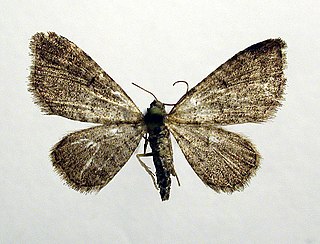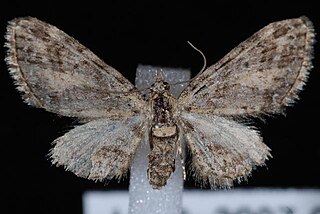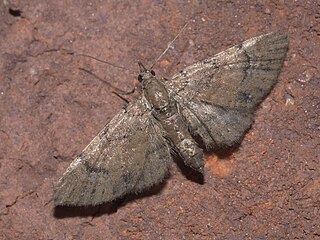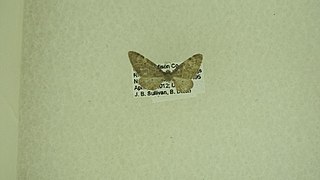
Eupithecia is the largest genus of moths of the family Geometridae, and the namesake and type genus of tribe Eupitheciini. Species in the genus are, like those of other genera in the tribe, commonly known as pugs. The genus is highly speciose, with over 1400 species, and members of the genus are present in most of the world with exception of Australasia. Roughly a quarter of described Eupithecia species occur in the Neotropical realm, where they have an especially high species diversity in the montane rain forests of the Andes. The genus includes a few agricultural pest species, such as the currant pug moth, Eupithecia assimilata, which is a pest on hops, and the cloaked pug moth, Eupithecia abietaria, which is a cone pest in spruce seed orchards.

The common pug(Eupithecia vulgata) is a moth of the family Geometridae. It is a common species across the Palearctic region, including the Near East and North Africa. It ranges from the Atlantic coast of Ireland and Portugal across Europe, the Middle East and Central Asia to the Russian Far East (Priamurje) and Korea.

The grey pug is a moth of the family Geometridae. It is found throughout the Palearctic region. It is also found in North America. Since it does not place any special demands on climatic conditions, special caterpillar food plants, geological subsoil or the like it is a typical species of almost any Hochstaudenflur, where it occurs in the herb layer, in bushes and even on deciduous trees. It can be found on forest edges and hedgerows, on heath, in rocky places and wetlands, parks and gardens, as well as in villages and town centres.

The juniper pug or juniper looper is a moth of the family Geometridae. The species was first described by Michael Denis and Ignaz Schiffermüller in 1775. It is found throughout the Palearctic and in the Nearctic.

Eupithecia plumbeolata, the lead-coloured pug, is a moth of the family Geometridae. The species can be found all over Europe ranging to the Urals, then through Central Asia to Siberia and to Sayan mountains, the Altai and the Amur. In the Alps, the species occurs up 2000 metres above sea level and in the Pyrenees up to in 2400 metres.

Eupithecia miserulata, the common eupithecia, is a moth of the family Geometridae. The species was first described by Augustus Radcliffe Grote in 1863 and it can be found in North America, from Ontario and Maine in the north to Florida, Mississippi, Louisiana and Texas in the south. It is also found in Arizona and California.

Eupithecia simpliciata, the plain pug, is a moth of the family Geometridae. It is found in the Palearctic realm, from western Europe to north-western China (Xinjiang). The species primarily colonizes wastelands, rubble and abandoned vineyards, and in Asia also salt steppes. In the Alps, the range of altitude extends up to 1200 metres.

Eupithecia venosata, the netted pug, is a moth of the family Geometridae, first described by the Danish zoologist Johan Christian Fabricius in 1787. It is found across the Palearctic realm from Portugal and Morocco in the west to the Lake Baikal in Siberia and Afghanistan and Pakistan in the east.

Eupithecia satyrata, the satyr pug, is a species of moth of the family Geometridae. It was described by Jacob Hübner in 1813. It is found from Ireland, through northern and central Europe east to all of Russia and central Asia and western Siberia to Tibet. It is also present in North Africa and North America.

Eupithecia distinctaria, the thyme pug, is a moth of the family Geometridae. It is found throughout Europe. It is also found in Iran. from the Iberian Peninsula through western and central Europe including the British Isles as well as further east as far east as far as Russia and Iran. In the north the range reaches as far as the southern Fennoscandia, to the south, where it is more common, it occupies the Mediterranean and Asia Minor. It is found primarily on warm, stony slopes and rocky structures as well as on sparse grassy areas with thyme mounds. In the Alps, it rises to heights of 2000 metres.

Eupithecia maestosa is a moth in the family Geometridae first described by George Duryea Hulst in 1896. It is found in North America from extreme western Alberta west to Vancouver Island, north to northern British Columbia and south to Texas and California. The habitat consists of wooded and shrubby areas.

Eupithecia jejunata is a moth in the family Geometridae. It is found in the United States, from eastern Texas, north into Arkansas and Missouri, east through Louisiana and Mississippi to Florida and north to coastal North Carolina.

Eupithecia peckorum, or Peck's pug moth, is a moth in the family Geometridae. The species was first described by Roger L. Heitzman and Wilbur R. Enns in 1977. It is found in the United States in eastern Texas, Missouri, Mississippi and Louisiana.

Eupithecia matheri is a moth in the family Geometridae first described by Frederick H. Rindge in 1985. It is found in the US states of Connecticut, New York, New Jersey, Pennsylvania, Virginia, North Carolina, Mississippi, Louisiana, Texas and possibly Kansas.

Eupithecia swettii is a moth in the family Geometridae first described by John Arthur Grossbeck in 1907. It is found in eastern North America, from Quebec and Massachusetts to North Carolina in the south-east and through Missouri and Kansas to Mississippi. It is also found in eastern Texas.
Eupithecia bolterii is a moth in the family Geometridae first described by George Duryea Hulst in 1900. It is found in the US states of Arizona and Texas.
Eupithecia pertusata is a moth in the family Geometridae. It is found the United States in south-western Texas, Arizona and New Mexico.
Eupithecia longidens is a moth in the family Geometridae. It is found in North America, including Texas, Arizona, New Mexico, Colorado and Utah.
Eupithecia alpinata is a moth in the family Geometridae first described by Samuel E. Cassino in 1927. It is found in the US states of Texas and Arizona.

Eupithecia zygadeniata is a species of moth in the family Geometridae. It was first described by Alpheus Spring Packard in 1876 and is found in North America, with records from Texas and Montana.















